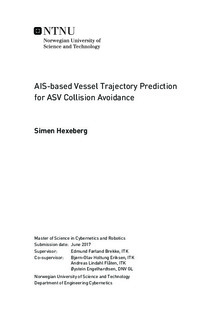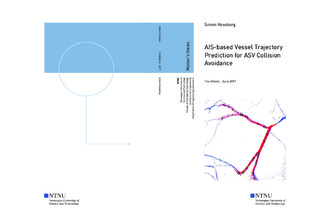| dc.description.abstract | The automotive industry has already taken a big step towards fully autonomous vehicles.
This trend is now spreading to the maritime industry with development of
autonomous surface vessels (ASVs). A reliable collision avoidance (COLAV) system
is essential in this context. In order to avoid collision with other vessels, one must
predict the future trajectories of nearby vessels. The constant velocity model (CVM)
is the prevailing approach for trajectory prediction in today s COLAV systems. The
main purpose of this thesis is to investigate to what extent it is possible to predict future
vessel trajectories based on historical automatic identification system (AIS) data
for prediction horizons up to about 15 minutes. A survey of other relevant prediction
methods are also presented.
Two new, AIS based methods for vessel trajectory prediction are developed and
tested: the single point neighbor search (SPNS) method and the neighbor course
distribution method (NCDM). Three speed prediction methods are also tested: the
straightforward constant speed method, a method using the median speed of the predicted
state s close neighbors (CNs) and lastly a linear transition in predicted time
between the two former methods.
The SPNS method is compared to a CVM approach and yields significantly better
results on curved trajectories, in terms of lower average and median path and
trajectory errors. However, a major part of vessels transit time is spent on straight
line trajectories. The SPNS algorithm shows also good path predicting capabilities on
close to straight line trajectories, although the CVM method yields the lowest errors in
such environments. The SPNS algorithm outputs a single predicted trajectory which
tends to follow the most AIS-dense sea lane ahead. Hence, it does neither facilitate
any uncertainty measure nor the possibility to suggest multiple possible route choices.
The more computational demanding NCDM algorithm, which outputs multiple predicted
trajectories, does better facilitate prediction uncertainty and it is also capable
of dividing the predicted trajectories into multiple branching sea lanes. Its predicted
positions at certain time instants are clustered with the density-based spatial clustering
of applications with noise (DBSCAN) algorithm. The predictions are further
statistically evaluated with respect to the distances to the nearest cluster centers.
Lastly, a computation time analysis is presented. The computational time is reduced
from an earlier version of the algorithm by storing data in a k-d tree. However,
the NCDM algorithm with the tested decision parameters is not practically feasible in
real-time. Several suggestions to reduce the computation time are given. | |

